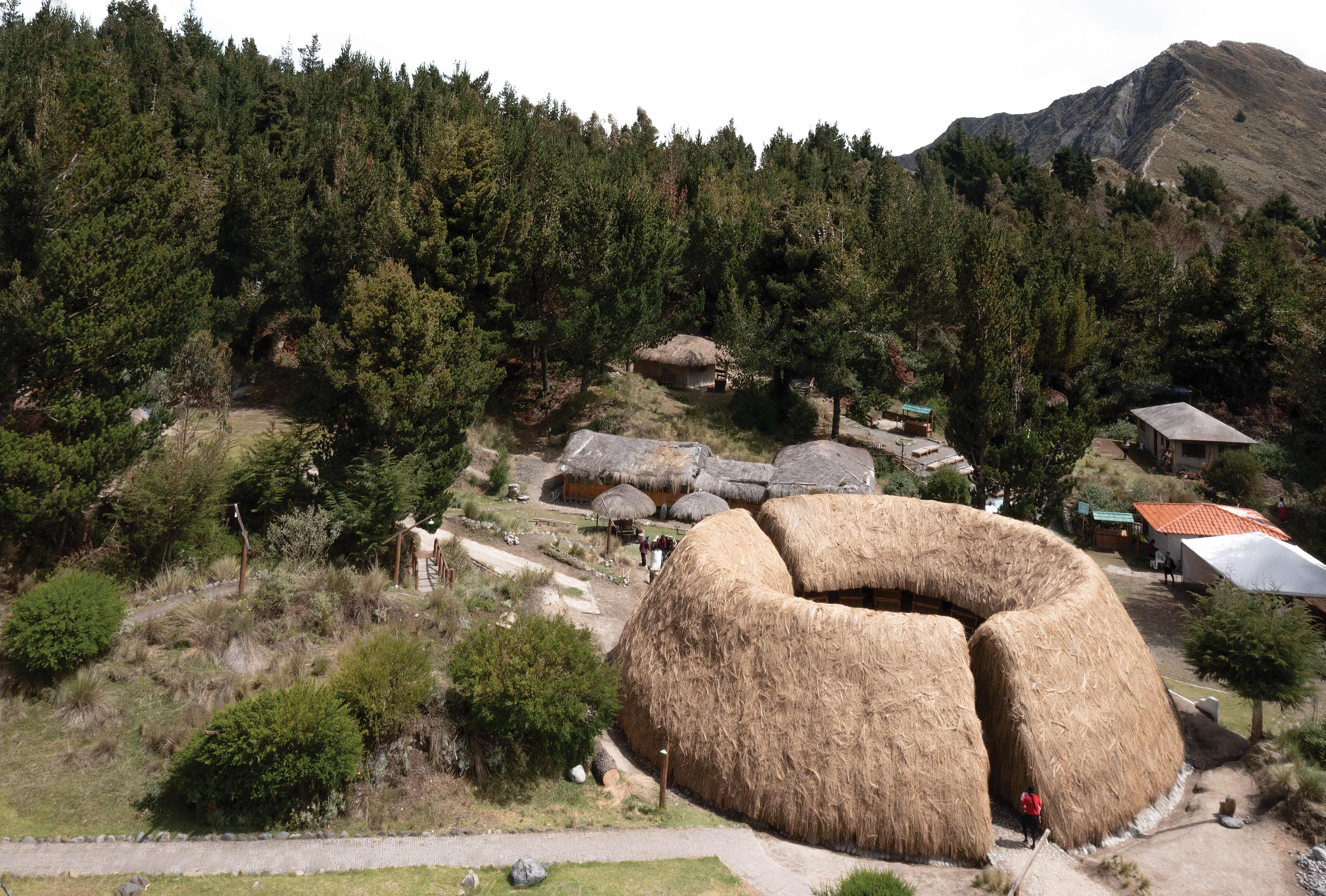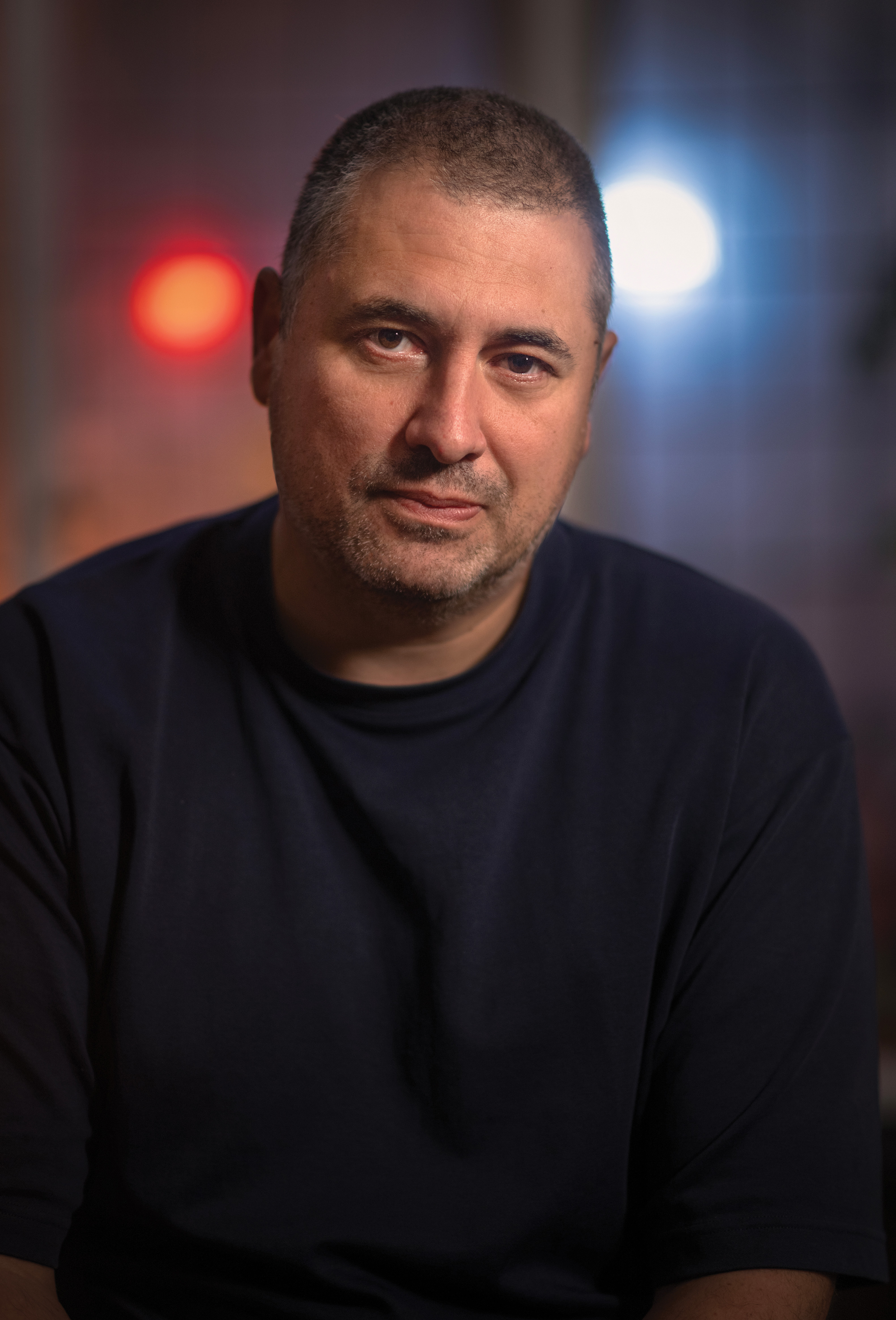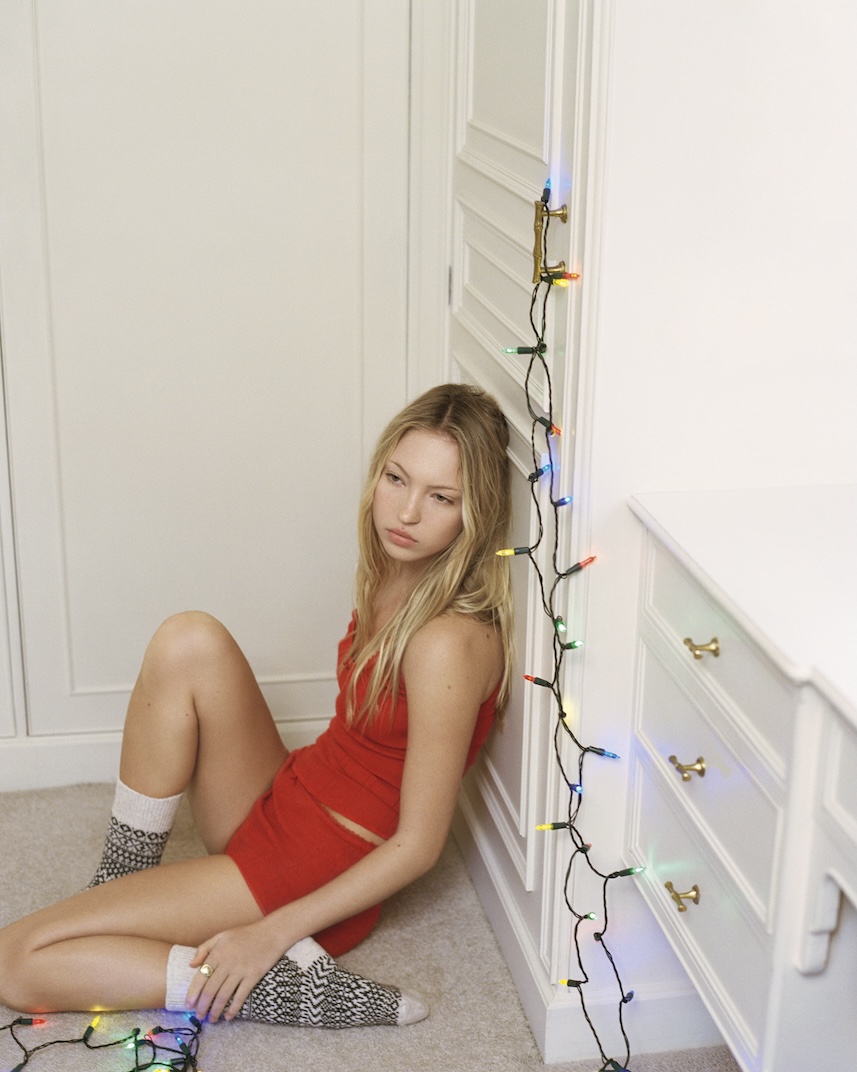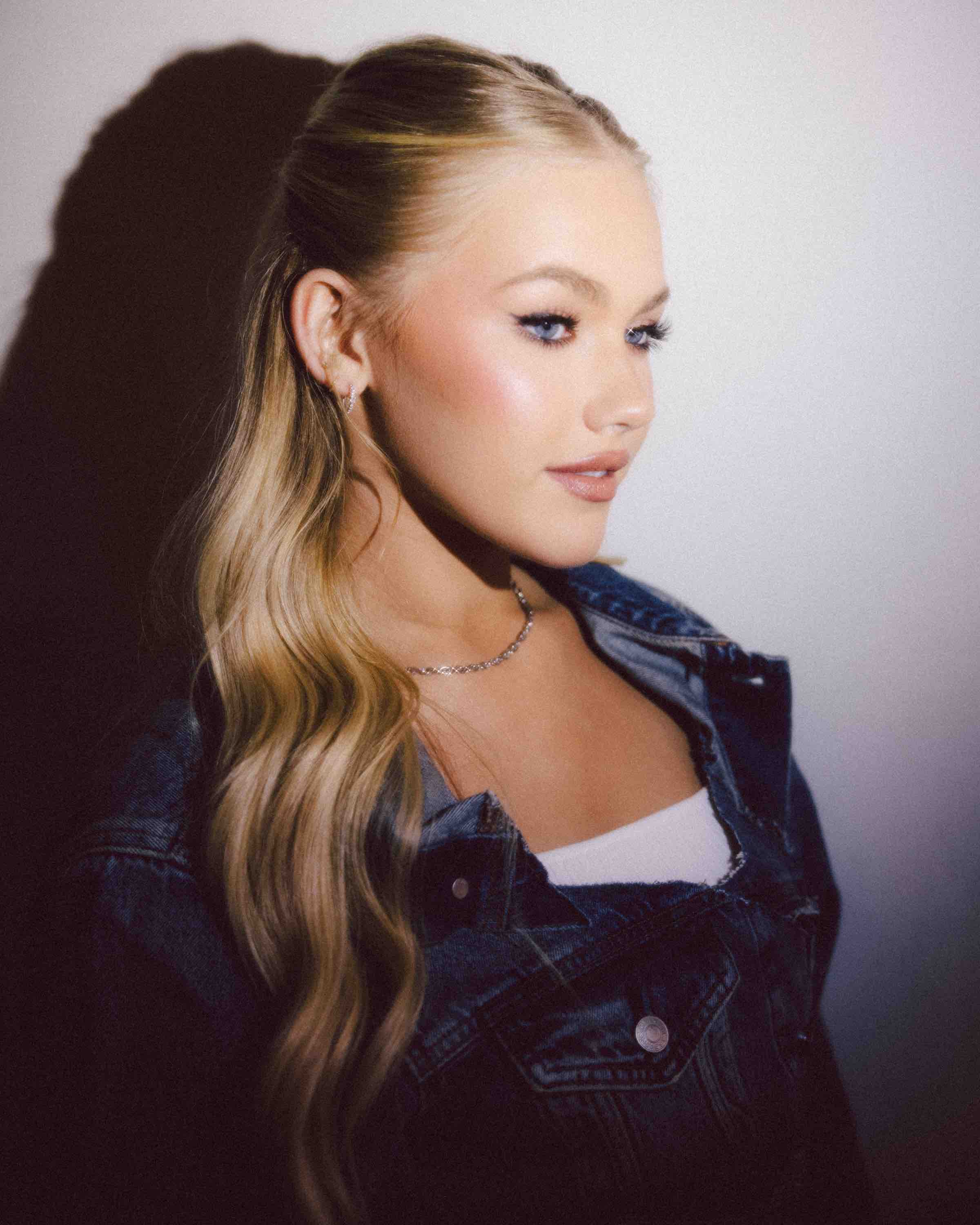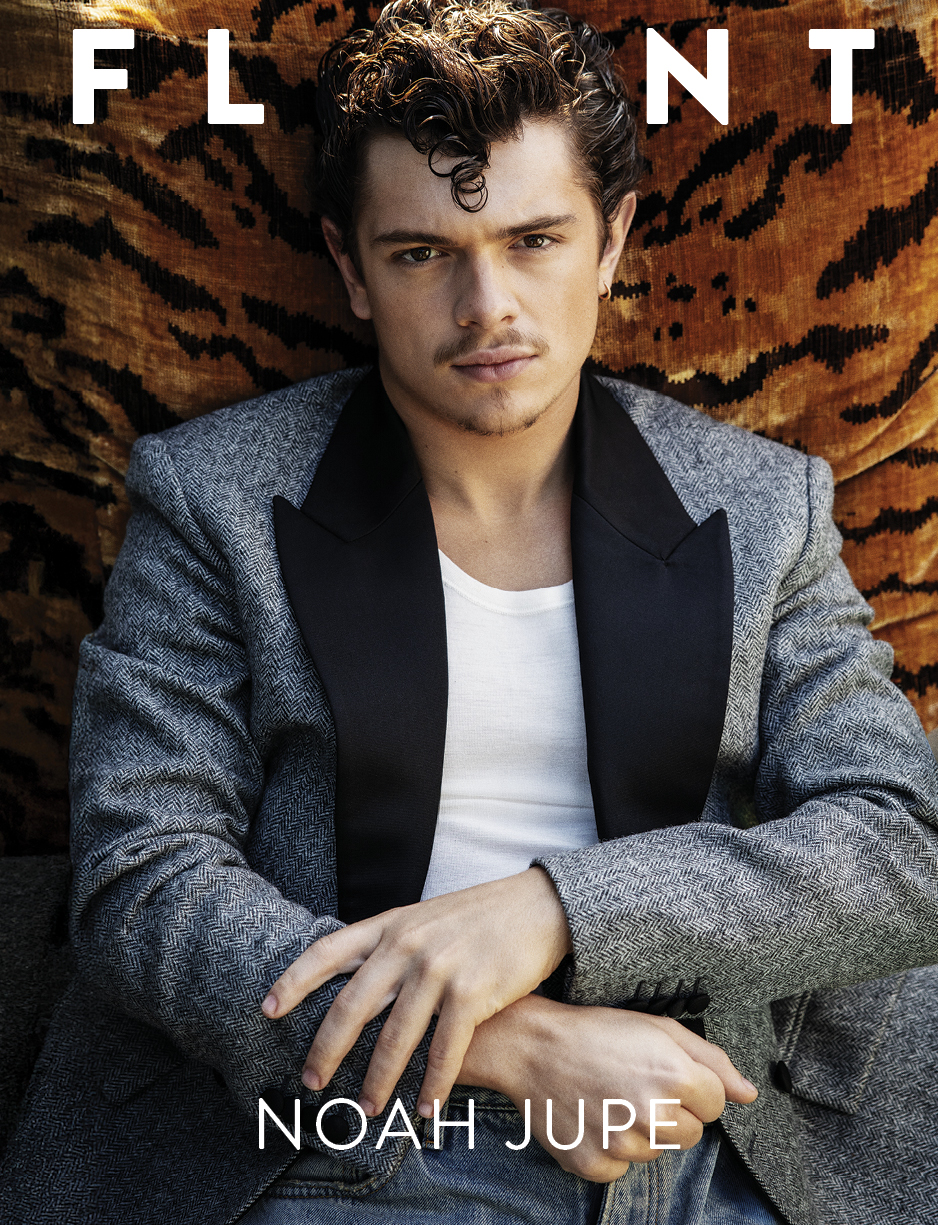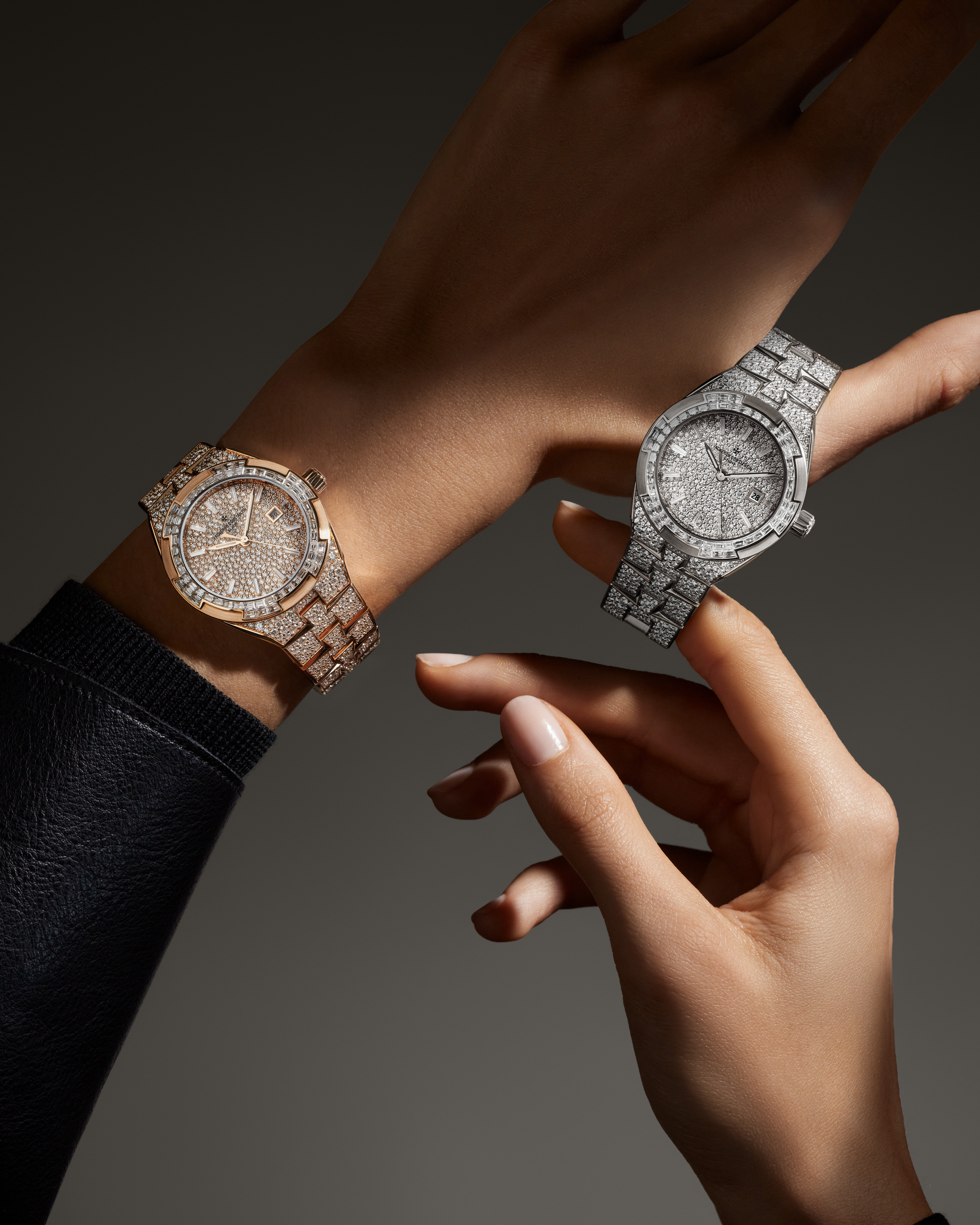

Photography by Amber Terranova
Working within a number of mediums over the years--from paintings and sculptures to film and back, New York-based artist Anton Ginzburg is now capturing the link to his ever-changing worlds with VIEWs, his first solo exhibit at the Helwaser Gallery. Intertwining his past and present, this exhibition analyzes that relationship, commenting on the ideas of migration and personal geometry along the way.
From a distance, Ginzburg’s pieces are meticulously crafted to the point of seeming almost mechanically created. Up close, each stroke is visible--revealing how the observer’s perspective is a process in constant motion, much like the physical crafting in itself. Flaunt sat down with Ginzburg to discuss past and future projects, the influences behind VIEWs and his life from Russia to New York.


Installation view of Anton Ginzburg: VIEWs
**_What was the transition from Russia to New York like?_**
I moved to New York in 1992 to study at The New School for my BFA. It was a really incredible experience coming from the last years of the Soviet Union to New York, which was like a different planet. And New York is also always changing, even if we compare the present period to that of the nineties. So you are always in motion, being here. When I moved, I had a really vague idea about what New York was and how to navigate it. But that is also the beauty of New York that you are forced to find your own trajectory. It has become home for me.
**_When did art become the forefront of your life?_**
I grew up in Saint Petersburg during Perestroika, which was a really exciting and hopeful period for Russia. You could feel changes and creativity in the air. There was a sense of freedom and liberation. And art, music, and cinema seemed meaningful and experimental. I guess it created a strong impression on me.
I got interested in art as a child. My mother had a close friend who was a curator at the Hermitage, and we used to visit her in the museum. And I got to spend a lot of time there getting to know classical and ancient art. And decided to become an artist then. Saint Petersburg had a strong classical art education in drawing, painting, and sculpture. So I enrolled myself in it and have been doing it ever since. I got my Master’s degree much later at Bard College, which exposed me to an amazing community in New York. I believe that art is a form of generating knowledge about the world, so it’s an ongoing process.
**_Can you talk a little about your Hyperborea series in 2011? What was the vision and meaning behind it?_**
Hyperborea was an exhibition that I was commissioned to present for the 54th Venice Biennale. The term “hyperborea” is a concept of a northern utopia, an equivalent of Atlantis, golden age of humanity. It was described as a real place by ancient Greek historians and geographers (Herodotus). And the concept resurfaced at the beginning of the twentieth century, as an attempt of many nations to claim certain moral superiority. I thought it was symptomatic when I saw a similar article in the Russian press, that claimed that archeological site of ‘real’ Hyperborea was discovered in Russia at the White Sea, paradoxically at the location of the very first Gulag camp. So I set to visit all the locations that claimed to be the site of Hyperborea (either historical, sensationalist or literary) and the project was a document of my research. It consisted of film, photos, paintings, sculptures and a book (published by Hatje Cantz).


Installation view of Anton Ginzburg: VIEWs
**_The ideas behind VIEWs (“evoking the range of possibilities inherent in the movement and transition between one place and another”) are very personal to your life. How did you get that connection to translate into your work?_**
Of course, the experience of immigration was significant for me. It makes you aware of how perception and self- awareness shift with displacement (both geographical and cultural). So the paintings and sculptures serve as instruments and diagrams to that process. They identify defamiliarization as a formal method, which I develop and position in my current context, of living in New York. I always try to keep a sense of playfulness and humor in the works.


_VIEW\_3A\_04_, 2018
Pigment and acrylic on wood
**_The pieces look like they took a very meticulous effort to create. What was the physical process like with VIEWs in relation to previous projects?_**
I start with gouache sketches where I figure out the compositions and color dynamics. Then I prepare boards and apply about eight layers of gesso, sanding it in between, until it becomes almost like a porcelain finish. When surfaces are ready for painting, I mix my paints from raw pigments and minerals. There is a fantastic pigment store in Hell’s Kitchen, and I was spending a lot of time there. There is mesmerizing beauty to raw pigments, and it’s one of my favorite places to go to in New York.

VIEW\_3A\_07, 2018
Pigment and acrylic on wood
* [](https://facebook.com/sharer.php?u=https%3A%2F%2Fimages.squarespace-cdn.com%2Fcontent%2Fv1%2F56c346b607eaa09d9189a870%2F1554851528199-L7EZURDX1EUEIZ8QCKL5%2FAnton%2BGinzburg.jpg&t=Flaunt%20Magazine%20-%20VIEW_3A_07%2C+2018+Pigment+and+acrylic+on+wood)
* [](https://twitter.com/intent/tweet?url=https%3A%2F%2Fimages.squarespace-cdn.com%2Fcontent%2Fv1%2F56c346b607eaa09d9189a870%2F1554851528199-L7EZURDX1EUEIZ8QCKL5%2FAnton%2BGinzburg.jpg&text=Flaunt%20Magazine%20-%20VIEW_3A_07%2C+2018+Pigment+and+acrylic+on+wood)
* [](http://pinterest.com/pin/create/link/?url=https%3A%2F%2Fimages.squarespace-cdn.com%2Fcontent%2Fv1%2F56c346b607eaa09d9189a870%2F1554851528199-L7EZURDX1EUEIZ8QCKL5%2FAnton%2BGinzburg.jpg&media=https%3A%2F%2Fimages.squarespace-cdn.com%2Fcontent%2Fv1%2F56c346b607eaa09d9189a870%2F1554851528199-L7EZURDX1EUEIZ8QCKL5%2FAnton%2BGinzburg.jpg&description=Flaunt%20Magazine%20-%20VIEW_3A_07%2C+2018+Pigment+and+acrylic+on+wood)

VIEW\_3A\_08, 2019
Pigment and acrylic on wood
* [](https://facebook.com/sharer.php?u=https%3A%2F%2Fimages.squarespace-cdn.com%2Fcontent%2Fv1%2F56c346b607eaa09d9189a870%2F1554851532864-AAK1VN8HHQ2RMQ6MOALJ%2FAnton%2BGinzburg.jpg&t=Flaunt%20Magazine%20-%20VIEW_3A_08%2C+2019+Pigment+and+acrylic+on+wood)
* [](https://twitter.com/intent/tweet?url=https%3A%2F%2Fimages.squarespace-cdn.com%2Fcontent%2Fv1%2F56c346b607eaa09d9189a870%2F1554851532864-AAK1VN8HHQ2RMQ6MOALJ%2FAnton%2BGinzburg.jpg&text=Flaunt%20Magazine%20-%20VIEW_3A_08%2C+2019+Pigment+and+acrylic+on+wood)
* [](http://pinterest.com/pin/create/link/?url=https%3A%2F%2Fimages.squarespace-cdn.com%2Fcontent%2Fv1%2F56c346b607eaa09d9189a870%2F1554851532864-AAK1VN8HHQ2RMQ6MOALJ%2FAnton%2BGinzburg.jpg&media=https%3A%2F%2Fimages.squarespace-cdn.com%2Fcontent%2Fv1%2F56c346b607eaa09d9189a870%2F1554851532864-AAK1VN8HHQ2RMQ6MOALJ%2FAnton%2BGinzburg.jpg&description=Flaunt%20Magazine%20-%20VIEW_3A_08%2C+2019+Pigment+and+acrylic+on+wood)
[](#)[](#)
**_Is there a specific period or artist that has influenced your work most over the years?_**
Looking at art from the past gives us a chance to engage with other time periods and ideas that defined reality and beliefs then. My interests change, and I love to discover new names and practices. Also, cinema and poetry are important sources of inspiration, as well as anthropological research. I am definitely influenced by the Russian tradition of a structural, formal method from the twentieth century, as well as French artists from the Surrealist circles and Oulipo. And of course I see some parallels between Russian Modernism and Brazilian Tropicalia.
**_Are there other mediums you’d like to explore in the future?_**
I am interested to work more with a narrative structure in film and performance. I love collaborations. A recent project was a commission from Dallas Symphony Orchestra, where I developed a video for the live musical performance of Sibelius and Wagner.
* * *
Written by: Elizabeth Pagano
 
Photography by Amber Terranova
Working within a number of mediums over the years--from paintings and sculptures to film and back, New York-based artist Anton Ginzburg is now capturing the link to his ever-changing worlds with VIEWs, his first solo exhibit at the Helwaser Gallery. Intertwining his past and present, this exhibition analyzes that relationship, commenting on the ideas of migration and personal geometry along the way.
From a distance, Ginzburg’s pieces are meticulously crafted to the point of seeming almost mechanically created. Up close, each stroke is visible--revealing how the observer’s perspective is a process in constant motion, much like the physical crafting in itself. Flaunt sat down with Ginzburg to discuss past and future projects, the influences behind VIEWs and his life from Russia to New York.

Photography by Amber Terranova
Working within a number of mediums over the years--from paintings and sculptures to film and back, New York-based artist Anton Ginzburg is now capturing the link to his ever-changing worlds with VIEWs, his first solo exhibit at the Helwaser Gallery. Intertwining his past and present, this exhibition analyzes that relationship, commenting on the ideas of migration and personal geometry along the way.
From a distance, Ginzburg’s pieces are meticulously crafted to the point of seeming almost mechanically created. Up close, each stroke is visible--revealing how the observer’s perspective is a process in constant motion, much like the physical crafting in itself. Flaunt sat down with Ginzburg to discuss past and future projects, the influences behind VIEWs and his life from Russia to New York.
 
Installation view of Anton Ginzburg: VIEWs
**_What was the transition from Russia to New York like?_**
I moved to New York in 1992 to study at The New School for my BFA. It was a really incredible experience coming from the last years of the Soviet Union to New York, which was like a different planet. And New York is also always changing, even if we compare the present period to that of the nineties. So you are always in motion, being here. When I moved, I had a really vague idea about what New York was and how to navigate it. But that is also the beauty of New York that you are forced to find your own trajectory. It has become home for me.
**_When did art become the forefront of your life?_**
I grew up in Saint Petersburg during Perestroika, which was a really exciting and hopeful period for Russia. You could feel changes and creativity in the air. There was a sense of freedom and liberation. And art, music, and cinema seemed meaningful and experimental. I guess it created a strong impression on me.
I got interested in art as a child. My mother had a close friend who was a curator at the Hermitage, and we used to visit her in the museum. And I got to spend a lot of time there getting to know classical and ancient art. And decided to become an artist then. Saint Petersburg had a strong classical art education in drawing, painting, and sculpture. So I enrolled myself in it and have been doing it ever since. I got my Master’s degree much later at Bard College, which exposed me to an amazing community in New York. I believe that art is a form of generating knowledge about the world, so it’s an ongoing process.
**_Can you talk a little about your Hyperborea series in 2011? What was the vision and meaning behind it?_**
Hyperborea was an exhibition that I was commissioned to present for the 54th Venice Biennale. The term “hyperborea” is a concept of a northern utopia, an equivalent of Atlantis, golden age of humanity. It was described as a real place by ancient Greek historians and geographers (Herodotus). And the concept resurfaced at the beginning of the twentieth century, as an attempt of many nations to claim certain moral superiority. I thought it was symptomatic when I saw a similar article in the Russian press, that claimed that archeological site of ‘real’ Hyperborea was discovered in Russia at the White Sea, paradoxically at the location of the very first Gulag camp. So I set to visit all the locations that claimed to be the site of Hyperborea (either historical, sensationalist or literary) and the project was a document of my research. It consisted of film, photos, paintings, sculptures and a book (published by Hatje Cantz).

Installation view of Anton Ginzburg: VIEWs
**_What was the transition from Russia to New York like?_**
I moved to New York in 1992 to study at The New School for my BFA. It was a really incredible experience coming from the last years of the Soviet Union to New York, which was like a different planet. And New York is also always changing, even if we compare the present period to that of the nineties. So you are always in motion, being here. When I moved, I had a really vague idea about what New York was and how to navigate it. But that is also the beauty of New York that you are forced to find your own trajectory. It has become home for me.
**_When did art become the forefront of your life?_**
I grew up in Saint Petersburg during Perestroika, which was a really exciting and hopeful period for Russia. You could feel changes and creativity in the air. There was a sense of freedom and liberation. And art, music, and cinema seemed meaningful and experimental. I guess it created a strong impression on me.
I got interested in art as a child. My mother had a close friend who was a curator at the Hermitage, and we used to visit her in the museum. And I got to spend a lot of time there getting to know classical and ancient art. And decided to become an artist then. Saint Petersburg had a strong classical art education in drawing, painting, and sculpture. So I enrolled myself in it and have been doing it ever since. I got my Master’s degree much later at Bard College, which exposed me to an amazing community in New York. I believe that art is a form of generating knowledge about the world, so it’s an ongoing process.
**_Can you talk a little about your Hyperborea series in 2011? What was the vision and meaning behind it?_**
Hyperborea was an exhibition that I was commissioned to present for the 54th Venice Biennale. The term “hyperborea” is a concept of a northern utopia, an equivalent of Atlantis, golden age of humanity. It was described as a real place by ancient Greek historians and geographers (Herodotus). And the concept resurfaced at the beginning of the twentieth century, as an attempt of many nations to claim certain moral superiority. I thought it was symptomatic when I saw a similar article in the Russian press, that claimed that archeological site of ‘real’ Hyperborea was discovered in Russia at the White Sea, paradoxically at the location of the very first Gulag camp. So I set to visit all the locations that claimed to be the site of Hyperborea (either historical, sensationalist or literary) and the project was a document of my research. It consisted of film, photos, paintings, sculptures and a book (published by Hatje Cantz).
 
Installation view of Anton Ginzburg: VIEWs
**_The ideas behind VIEWs (“evoking the range of possibilities inherent in the movement and transition between one place and another”) are very personal to your life. How did you get that connection to translate into your work?_**
Of course, the experience of immigration was significant for me. It makes you aware of how perception and self- awareness shift with displacement (both geographical and cultural). So the paintings and sculptures serve as instruments and diagrams to that process. They identify defamiliarization as a formal method, which I develop and position in my current context, of living in New York. I always try to keep a sense of playfulness and humor in the works.

Installation view of Anton Ginzburg: VIEWs
**_The ideas behind VIEWs (“evoking the range of possibilities inherent in the movement and transition between one place and another”) are very personal to your life. How did you get that connection to translate into your work?_**
Of course, the experience of immigration was significant for me. It makes you aware of how perception and self- awareness shift with displacement (both geographical and cultural). So the paintings and sculptures serve as instruments and diagrams to that process. They identify defamiliarization as a formal method, which I develop and position in my current context, of living in New York. I always try to keep a sense of playfulness and humor in the works.
 
_VIEW\_3A\_04_, 2018
Pigment and acrylic on wood
**_The pieces look like they took a very meticulous effort to create. What was the physical process like with VIEWs in relation to previous projects?_**
I start with gouache sketches where I figure out the compositions and color dynamics. Then I prepare boards and apply about eight layers of gesso, sanding it in between, until it becomes almost like a porcelain finish. When surfaces are ready for painting, I mix my paints from raw pigments and minerals. There is a fantastic pigment store in Hell’s Kitchen, and I was spending a lot of time there. There is mesmerizing beauty to raw pigments, and it’s one of my favorite places to go to in New York.

VIEW\_3A\_07, 2018
Pigment and acrylic on wood
* [](https://facebook.com/sharer.php?u=https%3A%2F%2Fimages.squarespace-cdn.com%2Fcontent%2Fv1%2F56c346b607eaa09d9189a870%2F1554851528199-L7EZURDX1EUEIZ8QCKL5%2FAnton%2BGinzburg.jpg&t=Flaunt%20Magazine%20-%20VIEW_3A_07%2C+2018+Pigment+and+acrylic+on+wood)
* [](https://twitter.com/intent/tweet?url=https%3A%2F%2Fimages.squarespace-cdn.com%2Fcontent%2Fv1%2F56c346b607eaa09d9189a870%2F1554851528199-L7EZURDX1EUEIZ8QCKL5%2FAnton%2BGinzburg.jpg&text=Flaunt%20Magazine%20-%20VIEW_3A_07%2C+2018+Pigment+and+acrylic+on+wood)
* [](http://pinterest.com/pin/create/link/?url=https%3A%2F%2Fimages.squarespace-cdn.com%2Fcontent%2Fv1%2F56c346b607eaa09d9189a870%2F1554851528199-L7EZURDX1EUEIZ8QCKL5%2FAnton%2BGinzburg.jpg&media=https%3A%2F%2Fimages.squarespace-cdn.com%2Fcontent%2Fv1%2F56c346b607eaa09d9189a870%2F1554851528199-L7EZURDX1EUEIZ8QCKL5%2FAnton%2BGinzburg.jpg&description=Flaunt%20Magazine%20-%20VIEW_3A_07%2C+2018+Pigment+and+acrylic+on+wood)

VIEW\_3A\_08, 2019
Pigment and acrylic on wood
* [](https://facebook.com/sharer.php?u=https%3A%2F%2Fimages.squarespace-cdn.com%2Fcontent%2Fv1%2F56c346b607eaa09d9189a870%2F1554851532864-AAK1VN8HHQ2RMQ6MOALJ%2FAnton%2BGinzburg.jpg&t=Flaunt%20Magazine%20-%20VIEW_3A_08%2C+2019+Pigment+and+acrylic+on+wood)
* [](https://twitter.com/intent/tweet?url=https%3A%2F%2Fimages.squarespace-cdn.com%2Fcontent%2Fv1%2F56c346b607eaa09d9189a870%2F1554851532864-AAK1VN8HHQ2RMQ6MOALJ%2FAnton%2BGinzburg.jpg&text=Flaunt%20Magazine%20-%20VIEW_3A_08%2C+2019+Pigment+and+acrylic+on+wood)
* [](http://pinterest.com/pin/create/link/?url=https%3A%2F%2Fimages.squarespace-cdn.com%2Fcontent%2Fv1%2F56c346b607eaa09d9189a870%2F1554851532864-AAK1VN8HHQ2RMQ6MOALJ%2FAnton%2BGinzburg.jpg&media=https%3A%2F%2Fimages.squarespace-cdn.com%2Fcontent%2Fv1%2F56c346b607eaa09d9189a870%2F1554851532864-AAK1VN8HHQ2RMQ6MOALJ%2FAnton%2BGinzburg.jpg&description=Flaunt%20Magazine%20-%20VIEW_3A_08%2C+2019+Pigment+and+acrylic+on+wood)
[](#)[](#)
**_Is there a specific period or artist that has influenced your work most over the years?_**
Looking at art from the past gives us a chance to engage with other time periods and ideas that defined reality and beliefs then. My interests change, and I love to discover new names and practices. Also, cinema and poetry are important sources of inspiration, as well as anthropological research. I am definitely influenced by the Russian tradition of a structural, formal method from the twentieth century, as well as French artists from the Surrealist circles and Oulipo. And of course I see some parallels between Russian Modernism and Brazilian Tropicalia.
**_Are there other mediums you’d like to explore in the future?_**
I am interested to work more with a narrative structure in film and performance. I love collaborations. A recent project was a commission from Dallas Symphony Orchestra, where I developed a video for the live musical performance of Sibelius and Wagner.
* * *
Written by: Elizabeth Pagano

_VIEW\_3A\_04_, 2018
Pigment and acrylic on wood
**_The pieces look like they took a very meticulous effort to create. What was the physical process like with VIEWs in relation to previous projects?_**
I start with gouache sketches where I figure out the compositions and color dynamics. Then I prepare boards and apply about eight layers of gesso, sanding it in between, until it becomes almost like a porcelain finish. When surfaces are ready for painting, I mix my paints from raw pigments and minerals. There is a fantastic pigment store in Hell’s Kitchen, and I was spending a lot of time there. There is mesmerizing beauty to raw pigments, and it’s one of my favorite places to go to in New York.

VIEW\_3A\_07, 2018
Pigment and acrylic on wood
* [](https://facebook.com/sharer.php?u=https%3A%2F%2Fimages.squarespace-cdn.com%2Fcontent%2Fv1%2F56c346b607eaa09d9189a870%2F1554851528199-L7EZURDX1EUEIZ8QCKL5%2FAnton%2BGinzburg.jpg&t=Flaunt%20Magazine%20-%20VIEW_3A_07%2C+2018+Pigment+and+acrylic+on+wood)
* [](https://twitter.com/intent/tweet?url=https%3A%2F%2Fimages.squarespace-cdn.com%2Fcontent%2Fv1%2F56c346b607eaa09d9189a870%2F1554851528199-L7EZURDX1EUEIZ8QCKL5%2FAnton%2BGinzburg.jpg&text=Flaunt%20Magazine%20-%20VIEW_3A_07%2C+2018+Pigment+and+acrylic+on+wood)
* [](http://pinterest.com/pin/create/link/?url=https%3A%2F%2Fimages.squarespace-cdn.com%2Fcontent%2Fv1%2F56c346b607eaa09d9189a870%2F1554851528199-L7EZURDX1EUEIZ8QCKL5%2FAnton%2BGinzburg.jpg&media=https%3A%2F%2Fimages.squarespace-cdn.com%2Fcontent%2Fv1%2F56c346b607eaa09d9189a870%2F1554851528199-L7EZURDX1EUEIZ8QCKL5%2FAnton%2BGinzburg.jpg&description=Flaunt%20Magazine%20-%20VIEW_3A_07%2C+2018+Pigment+and+acrylic+on+wood)

VIEW\_3A\_08, 2019
Pigment and acrylic on wood
* [](https://facebook.com/sharer.php?u=https%3A%2F%2Fimages.squarespace-cdn.com%2Fcontent%2Fv1%2F56c346b607eaa09d9189a870%2F1554851532864-AAK1VN8HHQ2RMQ6MOALJ%2FAnton%2BGinzburg.jpg&t=Flaunt%20Magazine%20-%20VIEW_3A_08%2C+2019+Pigment+and+acrylic+on+wood)
* [](https://twitter.com/intent/tweet?url=https%3A%2F%2Fimages.squarespace-cdn.com%2Fcontent%2Fv1%2F56c346b607eaa09d9189a870%2F1554851532864-AAK1VN8HHQ2RMQ6MOALJ%2FAnton%2BGinzburg.jpg&text=Flaunt%20Magazine%20-%20VIEW_3A_08%2C+2019+Pigment+and+acrylic+on+wood)
* [](http://pinterest.com/pin/create/link/?url=https%3A%2F%2Fimages.squarespace-cdn.com%2Fcontent%2Fv1%2F56c346b607eaa09d9189a870%2F1554851532864-AAK1VN8HHQ2RMQ6MOALJ%2FAnton%2BGinzburg.jpg&media=https%3A%2F%2Fimages.squarespace-cdn.com%2Fcontent%2Fv1%2F56c346b607eaa09d9189a870%2F1554851532864-AAK1VN8HHQ2RMQ6MOALJ%2FAnton%2BGinzburg.jpg&description=Flaunt%20Magazine%20-%20VIEW_3A_08%2C+2019+Pigment+and+acrylic+on+wood)
[](#)[](#)
**_Is there a specific period or artist that has influenced your work most over the years?_**
Looking at art from the past gives us a chance to engage with other time periods and ideas that defined reality and beliefs then. My interests change, and I love to discover new names and practices. Also, cinema and poetry are important sources of inspiration, as well as anthropological research. I am definitely influenced by the Russian tradition of a structural, formal method from the twentieth century, as well as French artists from the Surrealist circles and Oulipo. And of course I see some parallels between Russian Modernism and Brazilian Tropicalia.
**_Are there other mediums you’d like to explore in the future?_**
I am interested to work more with a narrative structure in film and performance. I love collaborations. A recent project was a commission from Dallas Symphony Orchestra, where I developed a video for the live musical performance of Sibelius and Wagner.
* * *
Written by: Elizabeth Pagano


